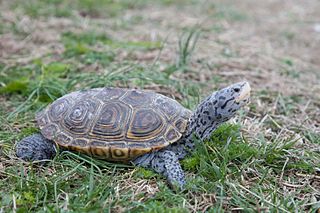
The red-eared slider or red-eared terrapin is a subspecies of the pond slider, a semiaquatic turtle belonging to the family Emydidae. It is the most popular pet turtle in the United States, is also popular as a pet across the rest of the world, and is the most invasive turtle. It is the most commonly traded turtle in the world.

The Geoemydidae are one of the largest and most diverse families in the order Testudines (turtles), with about 70 species. The family includes the Eurasian pond and river turtles and Neotropical wood turtles.

Emydidae is a family of testudines (turtles) that includes close to 50 species in 10 genera. Members of this family are commonly called terrapins, pond turtles, or marsh turtles. Several species of Asian box turtles were formerly classified in the family; however, revised taxonomy has separated them to a different family (Geoemydidae). As currently defined, the Emydidae are entirely a Western Hemisphere family, with the exception of two species of pond turtle.

Trachemys is a genus of turtles belonging to the family Emydidae. Members of this genus are native to the Americas, ranging from the Midwestern United States south to northern Argentina, but one subspecies, the red-eared slider, has been introduced worldwide. Species under this genus are commonly referred to as sliders.

The diamondback terrapin or simply terrapin is a species of terrapin native to the brackish coastal tidal marshes of the East Coast of the United States and the Gulf of Mexico coast, as well as in Bermuda. It belongs to the monotypic genus Malaclemys. It has one of the largest ranges of all turtles in North America, stretching as far south as the Florida Keys and as far north as Cape Cod.

The pond slider is a species of common, medium-sized, semiaquatic turtle. Three subspecies are described, the most recognizable of which is the red-eared slider, which is popular in the pet trade and has been introduced to other parts of the world by people releasing it to the wild. Hatchling and juvenile pond sliders have a green upper shell (carapace), yellow bottom shell (plastron), and green and yellow stripes and markings on their skin. These patterns and colors in the skin and shell fade with age until the carapace is a muted olive green to brown and the plastron is a dull yellow or darker. Some sliders become almost black with few visible markings. The carapace is oval with a bit of rounding and a central crest with knobs, but these features soften and fade with age, adults being smoother and flatter. For determining an adult slider's sex, males typically have much longer front claws than adult females, while females usually have shorter, more slender tails than males. Their lifespans range from 20 to 50 years.

The Big Bend slider, also called commonly the Mexican Plateau slider and la jicotea de la meseta mexicana in Mexican Spanish, is a species of aquatic turtle in the family Emydidae. The species is native to the Southwestern United States and northern Mexico.

The Cumberland slider, also called commonly the Cumberland turtle and Troost's turtle, is a subspecies of pond slider, a semiaquatic turtle in the family Emydidae. The subspecies is indigenous to the Southeastern United States.

The painted terrapin, painted batagur, or saw-jawed turtle is a species of turtles in the family Geoemydidae. It was formerly in its own genus, Callagur, but has been reclassified to the genus, Batagur.
The variable mud turtle, also known as Rhodesian mud turtle, Mashona hinged terrapin or variable hinged terrapin, is a species of turtle in the family Pelomedusidae. It is widely distributed in Central, East, and Southern Africa. The species was officially described by John Hewitt in 1927 and had to be broken into subspecies due to color variations on the heads of the turtles acrost the regions.

The northern red-bellied turtle or American red-bellied turtle is a species of turtle in the Pseudemys (cooter) genus of the family Emydidae.

The Maranhão slider, also commonly known as the Brazilian slider or Carvalho's slider, is a species of turtle in the family Emydidae.

The Deirochelyinae are a subfamily of the Emydidae consisting of species native to North and South America, some of which are frequently kept as pets. As a result of pet trade, one species, the red-eared slider, can now be found in many parts of the world.

The yellow-bellied slider is a land and water turtle belonging to the family Emydidae. This subspecies of pond slider is native to the southeastern United States, specifically from Florida to southeastern Virginia, and is the most common turtle species in its range. It is found in a wide variety of habitats, including slow-moving rivers, floodplain swamps, marshes, seasonal wetlands, and permanent ponds. Yellow-bellied sliders are popular as pets. They are a model organism for population studies due to their high population densities.

Batagur is a genus of large turtles from South and Southeast Asia. All members of the genus are seriously threatened. With a recent merger with members from two other genera, this genus has six described species.

The red-eared slider × yellow-bellied slider is an intergradation of a red-eared slider and yellow-bellied slider subspecies. Intergrade facial markings range from a yellow blotch behind each eye, which may join a yellow neck stripe forming a “C” figure when viewed from the left side to those with an almost indistinguishable amount of red in the eye blotch, to individuals that look similar to red-eared sliders with a red “ear” stripe that doesn’t join with a yellow neck stripe. In addition, the number of black blotches on the plastron varies in intergrades from two on the front scutes which is typical of yellow-bellied sliders, to a dark blotch on each scute which is typical of red-eared sliders. Intergrades are presumed to be omnivorous, but hatchlings and juveniles are more carnivorous than adults.















